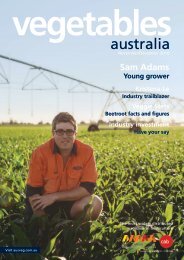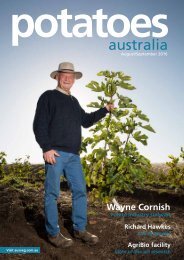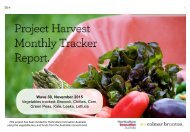potatoes
PA-DECJAN2016
PA-DECJAN2016
You also want an ePaper? Increase the reach of your titles
YUMPU automatically turns print PDFs into web optimized ePapers that Google loves.
31<br />
higher demand for <strong>potatoes</strong> as a<br />
substitute for wheat and gluten.<br />
Wave 5: January 2015<br />
Potato purchases fell this<br />
month, while consumer<br />
complaints doubled. An<br />
exploration into quality issues<br />
and checks across the supply<br />
chain was advised to minimise<br />
this problem.<br />
It was also found that<br />
consumers prefer an all-purpose<br />
variety of potato, rather than<br />
specific varieties that are suited<br />
to certain cooking methods.<br />
The report recommended<br />
investigating which <strong>potatoes</strong><br />
were most versatile and<br />
promoting these accordingly.<br />
The report indicated<br />
that triggers to purchasing<br />
<strong>potatoes</strong> differed across<br />
various consumer segments<br />
and therefore a multi-layered<br />
approach should be used. For<br />
example, brands and retailers<br />
could capture attention in-store<br />
and on packaging using multiple<br />
messages.<br />
Wave 6: February 2015<br />
The main barriers to purchasing<br />
<strong>potatoes</strong> this month revolved<br />
around quality issues<br />
and expense. The report<br />
recommended reassurance instore<br />
that despite aesthetic and<br />
superficial defects, the quality of<br />
the potato was not affected.<br />
The barrier of expense was<br />
shown to be primarily driven by<br />
consumer perceptions rather<br />
than an increase in retail price.<br />
In response, retailers could<br />
highlight best value options,<br />
such as loose and brushed<br />
<strong>potatoes</strong>.<br />
This month also showed a<br />
decrease in potato freshness<br />
perceptions. As well as ensuring<br />
that regular quality checks<br />
were in place and enforced, the<br />
report signalled an opportunity<br />
to educate consumers on<br />
correct storage methods to<br />
extend shelf life.<br />
Wave 7: March 2015<br />
This month showed a decrease<br />
in consumer satisfaction and<br />
a rise in the belief that they<br />
consumed enough <strong>potatoes</strong><br />
for their needs. The report<br />
suggested that consumers<br />
might be running out of ideas<br />
for <strong>potatoes</strong>, sparking an<br />
opportunity to promote a ‘potato<br />
of the month’ that is particularly<br />
good for seasonal dishes.<br />
Also noted was a sizable<br />
increase in the importance<br />
of provenance to consumers.<br />
Packaging and signage in-store<br />
could emphasise that <strong>potatoes</strong><br />
were grown in Australia, along<br />
with further information on the<br />
state or region.<br />
Another point of interest was<br />
the finding that consumers<br />
throw out 15 per cent of<br />
what they buy on average.<br />
This could be minimised<br />
by communicating storage<br />
information and best before<br />
dates, as well as ideas about<br />
how consumers can use the<br />
whole potato when cooking.<br />
Wave 8: April 2015<br />
This wave of research showed<br />
that there has been an<br />
increase in ‘quick meals’ that<br />
incorporate <strong>potatoes</strong>, which is<br />
reflected in their popularity as<br />
an accompaniment to a meal<br />
rather than a key ingredient.<br />
The report also indicated<br />
that the continued growth of<br />
Asian culture within Australia<br />
was likely to be contributing<br />
to the substantial decrease in<br />
tradition and habit as drivers<br />
to purchasing <strong>potatoes</strong>. The<br />
report recommended that<br />
potato versatility in multicultural<br />
cuisines should be highlighted.<br />
The topical issue of sugar was<br />
raised in the report as likely to<br />
be having a positive impact on<br />
earlier barriers to purchase,<br />
such as weight/diet and health<br />
concerns. Packaging and<br />
signage should clearly call out<br />
‘no sugar’, along with ‘low fat’<br />
and other health claims.<br />
Wave 9: May 2015<br />
The May report signalled an<br />
opportunity to promote larger<br />
formats of pre-packaged<br />
<strong>potatoes</strong>. It was found that 2kg<br />
pre-packaged bags are the ideal<br />
size and format, followed by 1kg<br />
and 5kg+ bags. This could be<br />
done by highlighting the value for<br />
money and the bag’s perfect size<br />
for the whole family.<br />
Although consumers like the<br />
value of larger pre-packaged<br />
bags, a barrier to purchase was<br />
the difficulty of carrying such<br />
bags. The report recommended<br />
investigating alternative<br />
packaging options, such as<br />
boxes with handles or sturdy<br />
hessian bags with handles.<br />
Another barrier to purchasing<br />
larger bags of <strong>potatoes</strong> was<br />
perceived shelf life. To encourage<br />
consumers to buy larger bags,<br />
the length of freshness could be<br />
clearly communicated on the<br />
packaging, including best before<br />
dates.<br />
Wave 10: June 2015<br />
The June report focused on four<br />
distinct segments of consumers<br />
in the marketplace. Particularly<br />
relevant to the industry is a<br />
segment of consumers called<br />
‘Wholesome Habits’ who eat<br />
<strong>potatoes</strong> routinely and are not<br />
looking for anything new, and<br />
another called ‘Eager Explorers’<br />
who are interested in the taste,<br />
colour and texture of <strong>potatoes</strong><br />
and are open to experimentation.<br />
The industry could increasingly<br />
target ‘Wholesome Habits’<br />
consumers by providing<br />
alternative meal occasions<br />
outside of dinner time, to<br />
make <strong>potatoes</strong> more relevant<br />
throughout the day. Formats<br />
could convey value for money<br />
Potatoes Australia December 2015/January 2016








